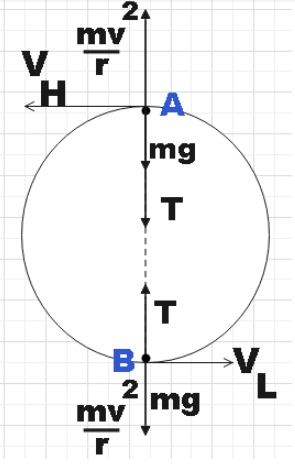
A stone is tied to a weightless string and revolves in a vertical circle of radius 5m. (1) What should be the minimum speed of the stone at the highest point of the circle so that the string doesn’t slack? (2) What should be the speed of the stone at the lowest point in this situation?
Answer
543k+ views
Hint: As a first step, you could consider the highest and the lowest point on the vertical circular motion. You could then balance all the forces acting on the stone. Rearranging the terms and substituting accordingly will give you the velocity at the highest point. Then you could use the law of conservation of energy to find the velocity at the lowest point.
Complete Step by step solution:
In the question, we are given a stone that is tied to some weightless string that is being revolved in a vertical circle of radius 5m. Then we have two sub questions to be solved. One is about the minimum speed of stone at highest point and the other is about the speed of stone at lowest point.

(1) For the highest point in the circular motion:
The forces acting on the stone can be balanced to get,
$T+mg=\dfrac{m{{v}_{H}}^{2}}{r}$
For minimum velocity at this point, the tension in the string at this point will be zero. Thus we get,
$\dfrac{m{{v}_{H}}^{2}}{r}=mg$
$\Rightarrow {{v}_{H}}\ge \sqrt{rg}$
Substituting the values,
$\Rightarrow {{v}_{H}}\ge \sqrt{5\times 9.8}$
$\therefore {{v}_{H}}\ge 7m{{s}^{-1}}$
Therefore, we have found that the velocity at the highest point to be $7m/s$.
(2) For the lowest point in the circular motion,
By law of conservation of energy at the highest and lowest points will be the same.
${{E}_{A}}={{E}_{B}}$
$\Rightarrow \dfrac{1}{2}m{{v}_{L}}^{2}=\dfrac{1}{2}m{{v}_{H}}^{2}+mg\left( 2r \right)$
$\Rightarrow \dfrac{1}{2}m{{v}_{L}}^{2}=\dfrac{1}{2}m\left( rg \right)+mg\left( 2r \right)$
$\Rightarrow {{v}_{L}}=\sqrt{5rg}$
Substituting the given values,
${{v}_{L}}=\sqrt{5\times 5\times 9.8}$
$\therefore {{v}_{L}}=7\sqrt{5}m{{s}^{-1}}$
Therefore, we found the velocity at the lowest point to be $7\sqrt{5}m/s$.
Note:
You may have noted that we have taken the direction of revolution of the stone to be in anti clockwise direction. The direction chosen is actually arbitrary and you may also choose it to be clockwise. This direction actually has no effect in the solution, so we shouldn’t bother about it much.
Complete Step by step solution:
In the question, we are given a stone that is tied to some weightless string that is being revolved in a vertical circle of radius 5m. Then we have two sub questions to be solved. One is about the minimum speed of stone at highest point and the other is about the speed of stone at lowest point.

(1) For the highest point in the circular motion:
The forces acting on the stone can be balanced to get,
$T+mg=\dfrac{m{{v}_{H}}^{2}}{r}$
For minimum velocity at this point, the tension in the string at this point will be zero. Thus we get,
$\dfrac{m{{v}_{H}}^{2}}{r}=mg$
$\Rightarrow {{v}_{H}}\ge \sqrt{rg}$
Substituting the values,
$\Rightarrow {{v}_{H}}\ge \sqrt{5\times 9.8}$
$\therefore {{v}_{H}}\ge 7m{{s}^{-1}}$
Therefore, we have found that the velocity at the highest point to be $7m/s$.
(2) For the lowest point in the circular motion,
By law of conservation of energy at the highest and lowest points will be the same.
${{E}_{A}}={{E}_{B}}$
$\Rightarrow \dfrac{1}{2}m{{v}_{L}}^{2}=\dfrac{1}{2}m{{v}_{H}}^{2}+mg\left( 2r \right)$
$\Rightarrow \dfrac{1}{2}m{{v}_{L}}^{2}=\dfrac{1}{2}m\left( rg \right)+mg\left( 2r \right)$
$\Rightarrow {{v}_{L}}=\sqrt{5rg}$
Substituting the given values,
${{v}_{L}}=\sqrt{5\times 5\times 9.8}$
$\therefore {{v}_{L}}=7\sqrt{5}m{{s}^{-1}}$
Therefore, we found the velocity at the lowest point to be $7\sqrt{5}m/s$.
Note:
You may have noted that we have taken the direction of revolution of the stone to be in anti clockwise direction. The direction chosen is actually arbitrary and you may also choose it to be clockwise. This direction actually has no effect in the solution, so we shouldn’t bother about it much.
Recently Updated Pages
A man running at a speed 5 ms is viewed in the side class 12 physics CBSE

The number of solutions in x in 02pi for which sqrt class 12 maths CBSE

State and explain Hardy Weinbergs Principle class 12 biology CBSE

Write any two methods of preparation of phenol Give class 12 chemistry CBSE

Which of the following statements is wrong a Amnion class 12 biology CBSE

Differentiate between action potential and resting class 12 biology CBSE

Trending doubts
What are the major means of transport Explain each class 12 social science CBSE

Which are the Top 10 Largest Countries of the World?

Draw a labelled sketch of the human eye class 12 physics CBSE

Explain sex determination in humans with line diag class 12 biology CBSE

Explain sex determination in humans with the help of class 12 biology CBSE

Differentiate between homogeneous and heterogeneous class 12 chemistry CBSE




